Use the form below to select from a collection of monthly summaries recapping climate-related occurrences on both a global and national scale.
Drought ReportJune 2007
| Contents Of This Report: |
 |

|
|
|
|
| At the end of June,
severe to extreme drought remained concentrated in the Southeast,
Southwest, and the western High Plains, as shown on the June 26 U.S.
Drought Monitor map. Severe to extreme short-term
dryness covered large parts of the country in June and led to
worsening conditions in areas that included the Midwest, Southeast,
and areas of the West. Eight of nine climate regions in the contiguous U.S. were drier than average in June and seven of nine were warmer than average. The combination of warmer and drier than average conditions brought much of Kentucky and surrounding areas from abnormally dry conditions in late May into severe drought. Drought conditions also worsened throughout large parts of the Southeast, including northern Alabama, where exceptional drought (the highest classification of drought) was widespread. Compare the May 29 and June 26 U.S. Drought Monitor maps to see these and other changes in drought severity that occurred in June. Drought in the Southeast region developed within the past several months. The 6-month Standardized Precipitation Index reflects the lack of rainfall since the start of the year. SPI values less than -2 stretched from eastern Kentucky to parts of southern Mississippi, reflective of drought conditions that occur less than once every 50 years. For the Southeast region as a whole, only 15.8 inches of precipitation fell during the first half of the year. This was nine inches less than normal and only 0.1 inches more than the lowest January-June precipitation total since records began in 1895; the record low occurred in 1898. As shown in the statewide precipitation rank map below, four southeastern states were much drier than normal for the year-to-date period and two (Mississippi and Alabama) had their driest such period on record. Only 16.3 inches of precipitation fell in Mississippi while 15.4 inches fell in Alabama, both totals only slightly more than half the 20th century average for each state. 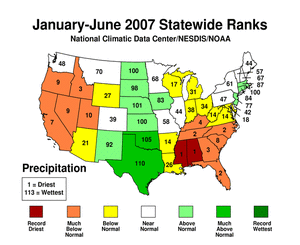 The Southeast region had it's driest April-June on record, and below average precipitation also stretched into the Midwest and parts of the Northeast, as shown in the 3-month statewide precipitation rank map. 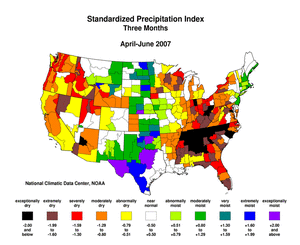 Five states in the Midwest and Northeast regions (WI, IN, OH, KY, and MD) were much drier than average for the same 3-month period. The large extent of the anomalously dry conditions are also evident in the 3-month SPI map above. However, near the end of June widespread drought had yet to develop throughout much of the Northeast and Midwest as depicted in the June 26, 2007 U.S. Drought Monitor. |
As shown in the statewide
rank map below, June precipitation totals were below average in
much of the western U.S., as seven of the 11 western states fell
within the drier than average tercile. This continued a pattern of
below average precipitation that has persisted throughout the West
since last year. This is reflected in the map of January-June
precipitation rankings and the rankings
for the past 12 months (July 2006 - June 2007).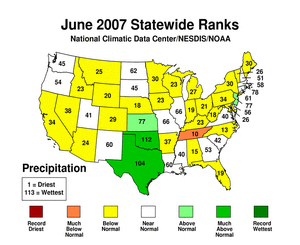 Los Angeles, California had its driest rain season (July to June) in its 130-year record. Only 3.21 inches of precipitation fell from July 1, 2006 through June 30, 2007, almost one foot below the normal total of 15.14 inches. This broke the previous record low of 4.42 inches, which was set during the 2001-2002 season. Although reservoir levels throughout much of California remain above average due to abundant snowfall that fell in the Sierra Nevada, Cascades, and Central Rockies during 2005-2006, the extremely dry cold season of 2006-2007 is having impacts throughout California and much of the West. In Oregon, very low river levels on the Columbia and Willamette rivers (Portland/Vancouver areas) are a possibility this summer and fall, according to the National Weather Service office in Portland, prompting notices to recreation and navigation interests. In Los Angeles, California, where approximately 50% of its water is supplied by melting snowpack from the Sierra Nevada mountains, mandatory water restrictions may soon be needed, according to.. Drought impacts in the Southeast include a ban on fireworks and open burning in 33 Alabama counties, and the initiation of a stage 3 water emergency plan in Birmingham and surrounding counties on June 7. Measures include a 200% surcharge for water use above 8977 gallons per month and limits on hand-watering to twice a week. These and hundreds of other impacts throughout the U.S. are summarized by the National Drought Mitigation Center's Drought Impacts Reporter. 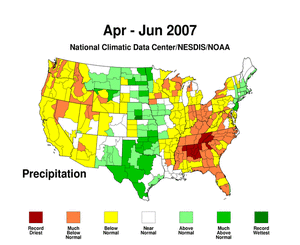 Drought conditions are also reflected in several indicators, including: divisional precipitation conditions as shown above, low soil moisture (modeled and observed), streamflow (modeled and observed), and snow-year precipitation, stressed vegetation, numerous large wildfires (June Wildfire Summary) deteriorating pastures. As of July 1, 95% of the pastures were in poor to very poor condition in California and, in Georgia, at 86%. |
|
| A detailed review of
drought and moisture conditions is available for all contiguous U.S.
states, the nine standard regions, and
the nation (contiguous U.S.): STATES: REGIONS:
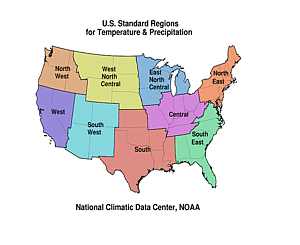
|
|
|
|
| While Georgia lies just outside of the hardest-hit region of the current Southeast drought, much of the state was classified as being in "severe" or "extreme" drought in the late June U.S. Drought Monitor. Even with near-normal rains in June, Georgia received only 8.65 inches of precipitation from March-June 2007 (51% of the 1950-2000 average), which is the driest March-June period since 1925, and the 2nd driest period since instrumental records began in 1895. |
| The graph to the right shows the March-June precipitation, 1896-2007, for Georgia (annual values in light blue, 5-year weighted average in dark blue). The graph also shows a 780-year tree-ring reconstruction of statewide March-June precipitation for Georgia (1206-1985; annual values in light red; 5-year smoothed values in dark red). This reconstruction was developed by Stahle and Cleaveland (1992) from two long, moisture-sensitive tree-ring records from bald cypress in Georgia. |
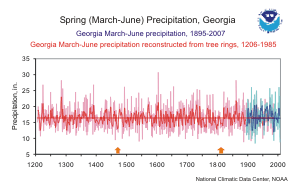 large image |
| The correlation
between the annual values of the tree-ring reconstruction and
March-June precipitation is 0.742, indicating a high degree of
shared variance. The reconstruction places the spring precipitation
variability of the last century in Georgia into a much longer-term
perspective. The tree-ring reconstruction shows multi-year periods of persistent spring drought (orange arrows) that appear to be as or more severe than many in the past century, particularly 1809-1819 (11 consecutive years with reconstructed below-average March-June precipitation) and 1467-1475 (9 consecutive years). While there are no individual years with reconstructed spring precipitation lower than the observed values for 1925 and 2007, when the uncertainty in the reconstructed values is considered, the reconstruction shows 20 instances prior to 1895 in which the spring precipitation was probably similar to, and possibly lower than, 1925 or 2007. This suggests that extreme spring droughts similar to 2007 have been a recurrent feature of the Georgia climate over the past 800 years, occurring about 2-3 times per century. |
 NOAA's National Centers for Environmental Information
NOAA's National Centers for Environmental Information

